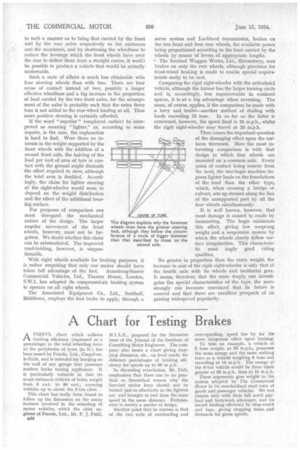A Chart for Testing Brakes
Page 48

If you've noticed an error in this article please click here to report it so we can fix it.
A USEFUL chart which collates braking efficiency (expressed as a percentage) to the total retarding force at the peripheries of tyres (in lb.) has been issued by Ferodo, Ltd., Chapel-enle-Frith, and is intended for hanging on the wall of any garage that possesses modern brake testing appliances. It is particularly valuable in that its scope embraces vehicles of laden weight from 5 cwt. to 80 cwt,, covering vehicles up to about the 2-ton class.
This chart has really been issued to follow up the discussion on the many features involved in the retarding of motor vehicles, which the chief engineer of Ferodo, Ltd., Mr. F. J. Field, M.I.A.E., prepared for the December issue of the Journal of the Institute of Consulting Motor Engineers. The company also issues a chart giving stopping distances, etc., on level roads, fot different percentages of braking effi ciency for speeds up to GO m.p.h.
In discussing retardation, Mr. Fielc, emphasizes that there can be no practical or theoretical reason why the heaviest motor lorry should not he braked just as effectively as the lightest car, and brought to rest from the same speed in the same distance. Performance is merely a matter of design.
Another point that he stresses is that of the two evils of overloading and over-speeding, speed has by far the more dangerous effect upon braking.
To take an example, a vehicle of 2 tons weight, at 26 m.p.h., possesses the same energy and the same striking force as a vehicle weighing 6 tons and travelling at 15 m.p.h. The energy of the 6-ton vehicle would be three times greater at 26 m.p.h. than at 15 m.p.h. These arguments give weight to the system adopted by The Commercial Motor in its standardized road tests of goods and passenger vehicles. We test chassis only with their full rated payload and bodywork allowance, and we record braking efficiency by stop-watch and tape, giving stopping times and distances for given speeds.




























































































